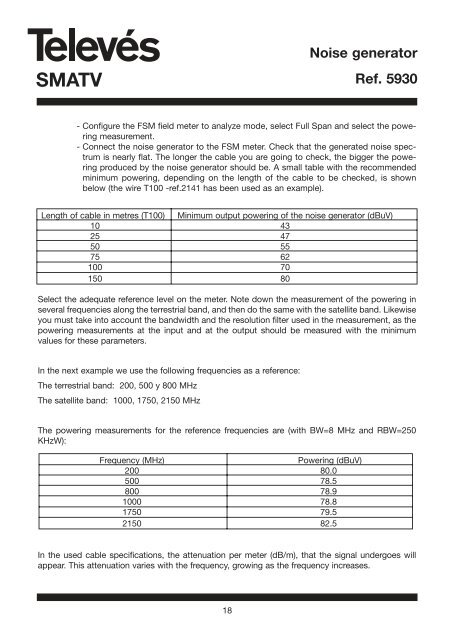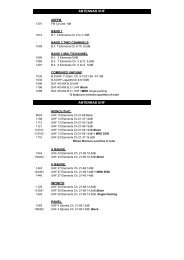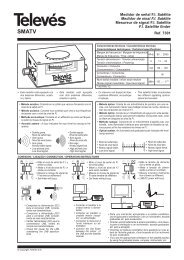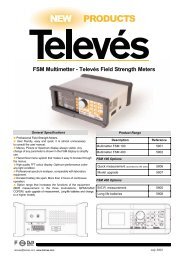SMATV Noise generator Ref. 5930
SMATV Noise generator Ref. 5930
SMATV Noise generator Ref. 5930
You also want an ePaper? Increase the reach of your titles
YUMPU automatically turns print PDFs into web optimized ePapers that Google loves.
<strong>SMATV</strong><br />
18<br />
<strong>Noise</strong> <strong>generator</strong><br />
<strong>Ref</strong>. <strong>5930</strong><br />
- Configure the FSM field meter to analyze mode, select Full Span and select the powering<br />
measurement.<br />
- Connect the noise <strong>generator</strong> to the FSM meter. Check that the generated noise spectrum<br />
is nearly flat. The longer the cable you are going to check, the bigger the powering<br />
produced by the noise <strong>generator</strong> should be. A small table with the recommended<br />
minimum powering, depending on the length of the cable to be checked, is shown<br />
below (the wire T100 -ref.2141 has been used as an example).<br />
Length of cable in metres (T100) Minimum output powering of the noise <strong>generator</strong> (dBuV)<br />
10 43<br />
25 47<br />
50 55<br />
75 62<br />
100 70<br />
150 80<br />
Select the adequate reference level on the meter. Note down the measurement of the powering in<br />
several frequencies along the terrestrial band, and then do the same with the satellite band. Likewise<br />
you must take into account the bandwidth and the resolution filter used in the measurement, as the<br />
powering measurements at the input and at the output should be measured with the minimum<br />
values for these parameters.<br />
In the next example we use the following frequencies as a reference:<br />
The terrestrial band: 200, 500 y 800 MHz<br />
The satellite band: 1000, 1750, 2150 MHz<br />
The powering measurements for the reference frequencies are (with BW=8 MHz and RBW=250<br />
KHzW):<br />
Frequency (MHz) Powering (dBuV)<br />
200 80.0<br />
500 78.5<br />
800 78.9<br />
1000 78.8<br />
1750 79.5<br />
2150 82.5<br />
In the used cable specifications, the attenuation per meter (dB/m), that the signal undergoes will<br />
appear. This attenuation varies with the frequency, growing as the frequency increases.





